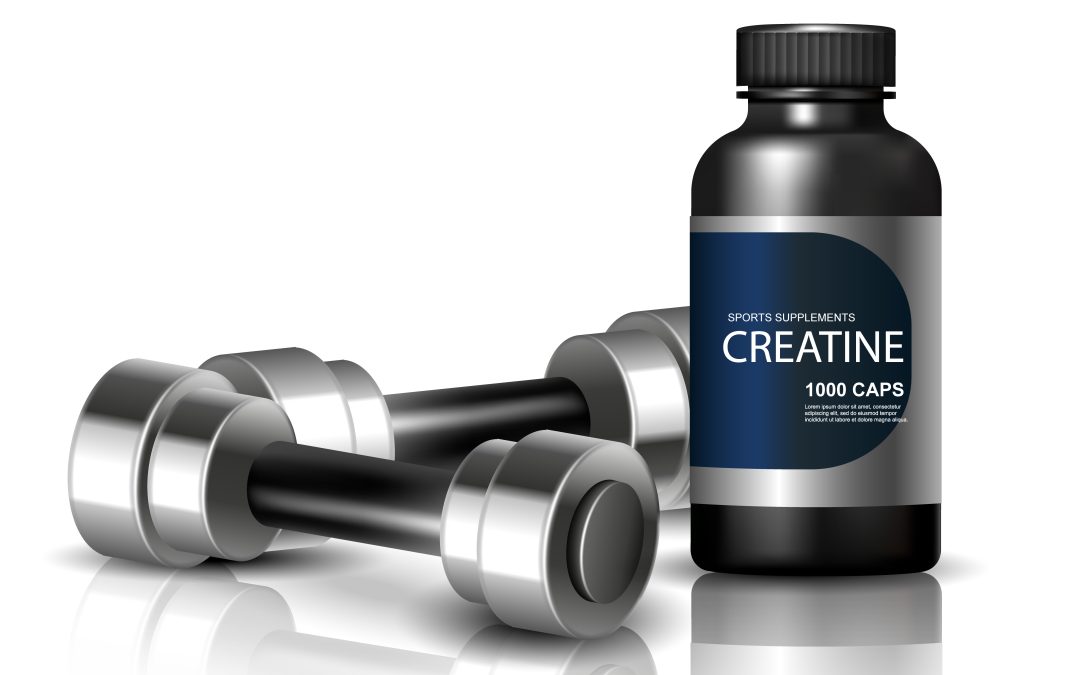Creatine is a substance that is found naturally in muscle cells. It helps your muscles produce energy during heavy lifting or high-intensity exercise.
About 95% of your body’s creatine is stored in muscles in the form of phosphocreatine. The other 5% is found in your brain, kidneys and liver.
How does it work?
Creatine can improve health and athletic performance in several ways.
In high-intensity exercise, its primary role is to increase the phosphocreatine stores in your muscles.
The additional stores can then be used to produce more ATP, which is the key energy source for heavy lifting and high-intensity exercise.
Creatine also helps you gain muscle in the following ways:
- Boosted workload: Enables more total work or volume in a single training session, which is a key factor in long-term muscle growth.
- Improved cell signalling: Can increase satellite cell signalling, which aids muscle repair and new muscle growth.
- Raised anabolic hormones: Studies note a rise in hormones, such as IGF-1, after taking creatine.
- Increased cell hydration: Lifts water content within your muscle cells, which causes a cell volumization effect that may play a role in muscle growth.
- Reduced protein breakdown: May increase total muscle mass by reducing muscle breakdown
- Lower myostatin levels: Elevated levels of the protein myostatin can slow or totally inhibit new muscle growth. Supplementing with creatine can reduce these levels, increasing growth potential
- Creatine supplements also increase phosphocreatine stores in your brain, which may improve brain health and prevent neurological disease
Effects on Muscle Gain
Creatine is effective for both short- and long-term muscle growth. It assists many different people, including sedentary individuals, older adults and elite athletes.
One 14-week study in older adults determined that adding creatine to a weight-training program significantly increased leg strength and muscle mass.
In a 12-week study in weightlifters, creatine increased muscle fiber growth 2–3 times more than training alone.
A large review of the most popular supplements selected creatine as the single most beneficial supplement for adding muscle mass.
Effects on Strength & Exercise Performance
Creatine can also improve strength, power and high-intensity exercise performance.
In one review, adding creatine to a training program increased strength by 8%, weightlifting performance by 14% and bench press one-rep max by up to 43%, compared to training alone.
In well-trained strength athletes, 28 days of supplementing increased bike-sprinting performance by 15% and bench-press performance by 6%
Just like your muscles, your brain stores phosphocreatine and requires plenty of ATP for optimal function.
Supplementing may improve the following conditions:
- Alzheimer’s disease
- Parkinson’s disease
- Huntington’s disease
- Ischemic stroke
- Epilepsy
- Brain or spinal cord injuries
- Motor neuron disease
- Memory and brain function in older adults
Vegetarians tend to have low creatine stores because they don’t eat meat, which is the main natural dietary source.
In one study in vegetarians, supplementing caused a 50% improvement in a memory test and a 20% improvement in intelligence test scores.
Although it can benefit older adults and those with reduced stores, creatine exhibits no effect on brain function in healthy adults.
Other Health Benefits
Research also indicates that creatine may:
- Lower blood sugar levels
- Improve muscle function and quality of life in older adults
- Help treat non-alcoholic fatty liver disease
However, more research in these areas is needed.
Different Types of Supplements
The most common and well-researched supplement form is called creatine monohydrate.
Creatine monohydrate is very cheap and is supported by hundreds of studies. Until new research claims otherwise, it seems to be the best option.
Dosage Instructions
Many people who supplement start with a loading phase, which leads to a rapid increase in muscle stores of creatine.
To load with creatine, take 20 grams per day for 5–7 days. This should be split into four 5-gram servings throughout the day.
Following the loading period, take 3–5 grams per day to maintain high levels within your muscles. As there is no benefit to cycling creatine, you can stick with this dosage for a long time.
If you choose not to do the loading phase, you can simply consume 3–5 grams per day. However, it may take 3–4 weeks to maximize your stores
Since creatine pulls water into your muscle cells, it is advisable to take it with a glass of water and stay well hydrated throughout the day.
Safety & Side Effects
Creatine is one of the most well-researched supplements available, and studies lasting up to four years reveal no negative effects .
There is also no evidence that creatine harms the liver and kidneys in healthy people who take normal doses. That said, those with preexisting liver or kidney problems should consult with a doctor before supplementing.
The Bottom Line
At the end of the day, creatine is one of the cheapest, most effective and safest supplements you can take.
It supports quality of life in older adults, brain health and exercise performance. Vegetarians — who may not obtain enough creatine from their diet — and older adults, may find supplementing particularly useful.
Creatine monohydrate is likely the best form. Try out creatine today to see if it works for you.

